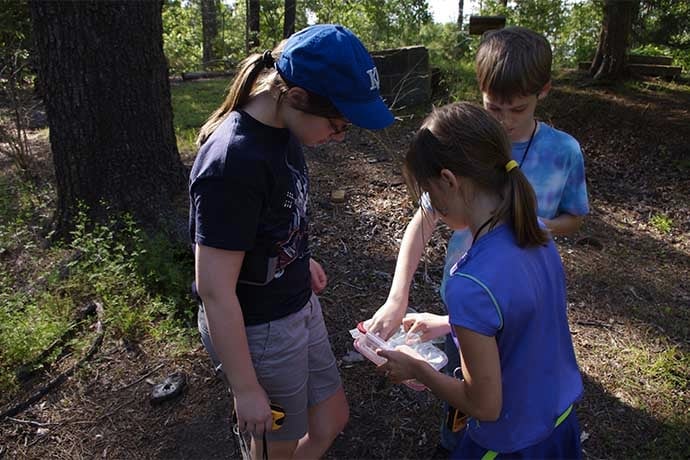Someone described geocaching as, “Using billions of dollars in military hardware [GPS] to find Tupperware in the woods.” In reality, it’s a fun way to use technology AND get outdoors with family, friends, and classmates. It’s a treasure hunt, often in your own community. It’s also a way to teach how to read maps and the limits of mapping technology.
How to Get Started Geocaching
Here’s what you’ll need:
- A device with GPS which likely is a smartphone but could be a GPS receiver.
- A free account at Geocaching.com to find caches near you.
- If you use a smartphone, a free Android or iOS Geocaching app.
- If you’re in the woods or open fields, wear long pants, long shirts, hats, and likely boots.
- Snacks because it might take awhile to find a cache.
- Pen or pencil and paper.
- Small trinkets to leave or swap in the caches you find.
How Geocaching Works
The fun interesting part of geocaching is that caches are literally everywhere, including Wall Street. Plenty of caches are hidden outdoors near trees and streams but there’s a good chance caches are in your town or city, too. It’s an alternate universe where people have hidden small boxes (or Tupperware) for other people to find.
The first step is to set up a free account at Geocaching.com and to decide on a GPS device, either your smartphone or a dedicated receiver. The smartphone option might work best because likely you’ll use it to find maps, look up caches while outside, and other tasks. If you use a phone, download either the Android or iOS app.
If you’ll be out in nature, definitely dress appropriately and check the weather. If you’re with kids, get them involved in every step of the process. It’s a fun way to teach them about process and how to make decisions, whether it’s what to look for, where to find things, or what clothes to wear.
Once you’re geared up, the next step is to find your first cache. Some caches are disturbed or difficult to find. It’s a great idea to identify three or four possible caches in addition to the one you want to start finding. If your first cache can’t be found, you can go on to the next one.
Keeping caches secret is a key part of geocaching. You don’t want to encourage someone to move or destroy a cache. So be sure no one else is around when you think you’ve actually found a cache.
Once you find a cache, open it. Inside you’ll likely find a piece of paper with names on it. Add your name with the pen or pencil you bring along. You also might find small trinkets, often plastic charms or similar stuff. If you’ve brought trinkets, feel free to trade with what’s in the cache.
After you find a cache, you also can use Geocaching.com to announce your find. And you can sign up to receive emails when others find the cache. If you find a trackable in the cache, an item with a unique ID number on it, a kind of game piece, don’t take it unless you plan to move it to another cache and use Geocaching.com to let everyone know the item has moved.
What Could Go Wrong?
In some ways, caches outdoors work better for kids than city caches. There’s less risk a child will run into traffic if you’re on a trail looking at trees and paths to figure out where a cache is located.
There’s also a possibility caches cannot be found. Maybe they’re too well hidden, or you and your kids are bad at finding things, or someone has destroyed the cache. While you can prepare for this possibility by having a small list of alternate caches to find, not finding a cache could be a teachable moment. Adding geocaching as a side activity for a day trip is another way to minimize this risk.
What’s Next?
Geocaching is a fun activity to try at least once. There’s a million people plus community around the world who love to find and hide caches. If you or your kids really enjoy it, definitely join the community and contribute.
If geocaching is fun but interest wanes, you can still find caches as part of future day trips and vacations, or class projects if you’re a teacher with students. I still get emails for two caches I looked for on a trip to Meredith, New Hampshire a few years ago. It’s fun to get an email saying someone else found the caches and, by extension, that the caches are still there.
Did you know? Since this magazine is about how we use technology and it’s impact on our lives, you also might be interested to know the use of digital maps has a negative impact on our biological sense of direction. Moving around in physical space works different parts of the brain than checking a map every few minutes. Because digital technologies are so new, as a species humans have not figured out how to adapt our sense of direction.
Learn More
Geocaching.com
https://www.geocaching.com/
https://www.geocaching.com/guide/
https://www.youtube.com/user/GoGeocaching#cat=cat:newbies&vid=1YTqitVK-Ts
Geocaching with Kids
https://www.washingtonparent.com/articles/1205/geocaching-with-kids.php
https://www.rei.com/learn/expert-advice/geocaching-kids.html
http://familysponge.com/play/family-adventures/geocaching-with-kids/
5 Tricks of the Trade for Geocaching with Kids
Advice from a middle school teacher who takes her classes out geocaching.
https://www.geocaching.com/blog/2014/04/5-tricks-of-the-trade-for-geocaching-with-kids/

